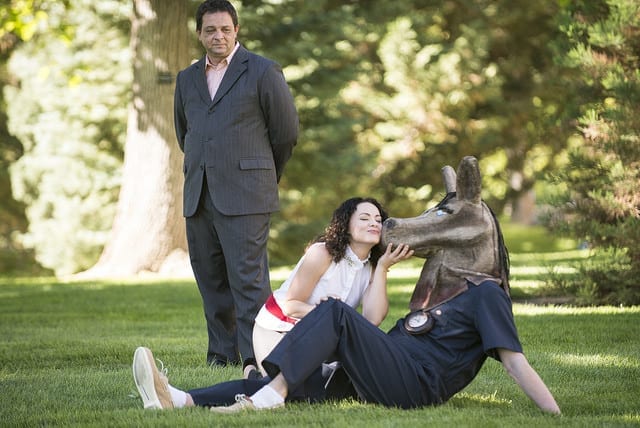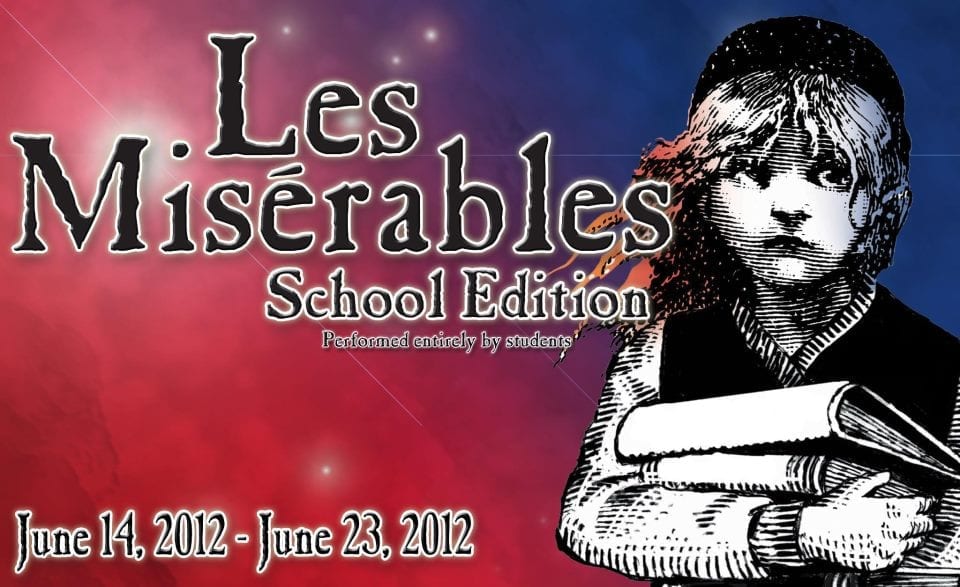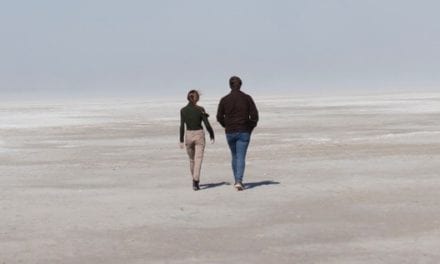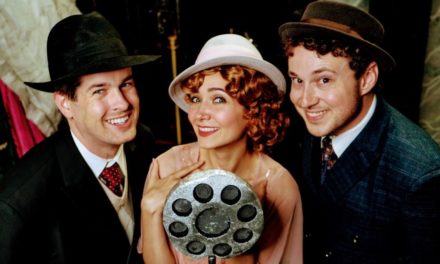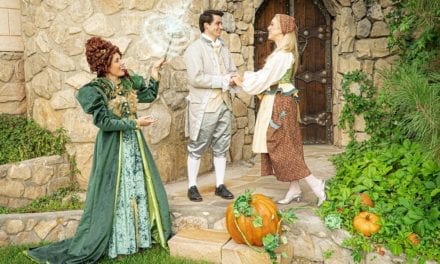SALT LAKE CITY — A Midsummer Night’s Dream is probably the most performed of Shakespeare‘s comedies. It is still very funny and accessible for modern audiences and seems custom made for the summer theatre season. Salt Lake Shakespeare, celebrating it’s 20th season, has become known for it’s fresh and high energy takes on both popular and lesser known selections from the Shakespearean canon. When I saw that the two were meeting this season, I thought it would be a wonderful match. Not so much.
Midsummer is set in Athens, Greece, just before Duke Theseus’s wedding to the Amazon Queen Hippolyta, and it features three distinct classes of characters that meet in magical wooded happenstance on one midsummer night. First, the lovers: four young (and usually aristocratic) people caught in an awkward love rectangle flee to the woods desperate for each other and to escape adult interference. Next are the mechanicals: craftsmen of Athens who choose the woods as a secret rehearsal space for their entry into the equivalent of a local talent search. Lastly, the fairies: King Oberon and Queen Titania who are having a supernatural lover’s spat and custody battle (also in the woods).
Given this list of characters and subplots, this play could very easily become confusing, but Shakespeare’s language and careful plotting hold up the story and unfold the events with surprising sense. That is kind of the trick to this play: just trusting the plot. Many productions usually add a “concept” to modernize or rejuvenate the over 400 year old text. Director Hugh Hanson chooses not only modernize the setting, having take place in modern day Athens, but also to “mash” the play with Alice in Wonderland. True, both stories focus on dream, but I felt that this forced and unclear concept paired with an unwieldy cutting of the text made an already easily confused story absolutely and irredeemably convoluted.
Hanson’s version makes Hermia (played by Ana Lemke), one of the lovers, into the Alice figure. It is her dream, inspired by a projected YouTube trailer featuring the Salt Lake Shakespeare apprentices in a musical version of Alice, that seems to justify the mashup concept. Characters from her waking life show up transformed as Lewis Carroll’s characters. First, her boyfriend Lysander (Logan Tarantino) shows up as what I think was the March Hare. Next, her best friend Helena (Olivia Vessel) presents Hermia with a comically long pinafore. Later, Lysander’s rival—and beloved of Helena—Demetrius (Joseph Paul Branca) is presented as the Mad Hatter. Never (with the exception of Tarantino’s Lysander) are the distinctions between dream and waking characters made clear, and the costumes (designed by Amanda Reiser) seem to be either too little to adequately represent the characters or giant hindrances to the action. This is very clear with the fairies. Oberon and Titania are cast as the King and Queen of hearts, and while this is the clearest visual representation of the concept both performers spent much of their time fighting against the royal capes in order to complete simple actions.
 The mechanicals do share a clever moment of blocking in their second scene when five performers enter as one to represent the caterpillar and then break off to be individual supporting Wonderland characters, like the Dodo, Mock Turtle, and the Duck. I really liked that these characters were depicted with masks, however much of the dialogue was lost and there was little to no physicality to enhance the mask work. Adding to the muddle, there was no clarification as to why the mechanicals and the fairies would be present in Hermia’s dream without directly interacting with her. The one and only instance where the combination of these two worlds even remotely worked for me was with the casting of Puck as the Cheshire Cat. As Puck, Trevor Blair embraced the mischievous nature of the cat and played the Oberon’s trickster henchman to the hilt. Even though his performance was at times one-dimensional (a problem inherent throughout), Blair was the only true example of the promise of the concept.
The mechanicals do share a clever moment of blocking in their second scene when five performers enter as one to represent the caterpillar and then break off to be individual supporting Wonderland characters, like the Dodo, Mock Turtle, and the Duck. I really liked that these characters were depicted with masks, however much of the dialogue was lost and there was little to no physicality to enhance the mask work. Adding to the muddle, there was no clarification as to why the mechanicals and the fairies would be present in Hermia’s dream without directly interacting with her. The one and only instance where the combination of these two worlds even remotely worked for me was with the casting of Puck as the Cheshire Cat. As Puck, Trevor Blair embraced the mischievous nature of the cat and played the Oberon’s trickster henchman to the hilt. Even though his performance was at times one-dimensional (a problem inherent throughout), Blair was the only true example of the promise of the concept.
Don’t get me wrong, this production was full of potential. I applaud Hanson for making many bold choices with his casting, cutting, and concept. I just wish there had been more clarity. The dialogue was often rushed and the company in general lacked sufficient enunciation to keep the text clear. Lines were also frequently run over in favor of laughter garnered for improv-style physical comedy bits. The final play within a play, which is usually the time for the mechanicals to shine, felt like a second string Saturday Night Live sketch with the actors just on the brink of laughing at their own ridiculousness.
As the weaver-cum-stunted actor Bottom, Linton Dean has the makings of a comedy pro but the comedy from his malapropism laden text is barely acknowledged and is rather focused on easy schtick. Emilia Stawicki as Petra Quince suffers most from this. Peter Quince the carpenter is often cast as a woman, yet Stawicki is so stuck as a bow legged tomboy that her purpose is almost entirely lost. The other mechanicals experience similar fates: Kaltin Kirby as Francis Flute is reduced to a short joke. Christian Seiter as Snout has no clear reason to be on stage except to get kneed in the groin. Justin Tsatsa‘s sole responsibility as Starvling seemed to be to make added pop-culture references, like asking for a selfie with the group. And Paul Chaus as the uncertain Snug was either supposed to be stoned or the cheap choice of being developmentally disabled.
Several actors were also double cast. Melanie Nelson as both fairy queen Titania and the Amazon Hippolyta appeared to be the only one completely comfortable with the antiquated language. Adam Tyler played fairy king Oberon as impish and uncertain, a strong if unusual contrast to his smug and entitled turn as Duke Theseus. Taylor Camelot, Jasmin Peterson, and Katheryn Mungin were lovely as the fairies (save for a regrettable outbreak of rap during Titania’s lullaby), but were mostly relegated to geting props off and on stage.
This frustrating lack of clarity spread to the technical side as well. Set designer Kevin Dudley utilizes the limited space in the Babcock Theatre with a back drop of slick sliding panels that allowed for quick scene changes and acted as a screen for projections meant to define setting. These projections (designed by David Evanoff) established place and tried to highlight the Wonderland vibe, but in the small space the actors’ faces and torsos were often covered once they moved upstage. Seth Miller‘s lighting had wonderful moments of atmosphere, but again the actors were lost in this moodiness. Titania’s “forgeries of jealousy” speech is delivered almost entirely in shadow. Sound designer and composer Jen Jackson worked with live percussionist Jared Cragun to create a whimsical soundtrack and live foley for the play. This was probably the most successful component of the night. However, several filmed segments had audio so low I had to strain to follow what they were intended to communicate.
I left opening night feeling deflated and disappointed. The level of training and obvious potential of the whole company is remarkable, but I felt that the lack of clarity, shallow character relationships, the competition between actor and technical components, the odd cutting, and long running time (over two hours) really missed the mark. A Shakespeare comedy needs to be brisk and snappy. This production seemed stilted from lack of energy in the action, which was clear from the first moment the first actor entered and began with a sigh. While I did not laugh, the rest of the audience was warm and receptive. However, I got the distinct feeling that the laughers were responding to the sight of someone they knew in a ridiculous situation and not the humor in this comedy.
Audience members should know the play is supplemented with a “Green Show” starting at 6:45 PM performed on the plaza in front of Pioneer Memorial Theatre. This was not widely advertised, and so I missed all but the last three minutes. It appears to be a showcase for Youth Theatre students. Parking is also heavily and very inconveniently impacted by the closing of the PTC lot.

